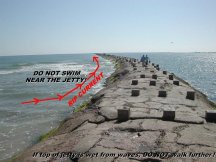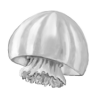BEACH
and OCEAN SAFETY INFORMATION
For Visitors to South Padre Island
FLAG
ADVISORY SYSTEM |
Surf
Conditions |
FLAG
ADVISORY SYSTEM |
sistema
de aviso con bandera |
| .... |
-heavy
surf
-dangerous currents |
-oleaje
fuerte
-corrientes Peligrosas |
| .... |
-calm
to moderate water
-does not mean safe water |
-agua
calmada a moderada
-no asuma agua segura |
| .... |
-presence
of
venemous marine life |
-presencia
de
vida marina venenosa |
Absence
of flag does not assure safe water
La ausencia de banderas no asume
condiciones de agua segura |
Dial
911 for emergency
Marque el 911 para urgencias |
|
As
you enter beaches you will notice the Flag Advisory
signs.
|
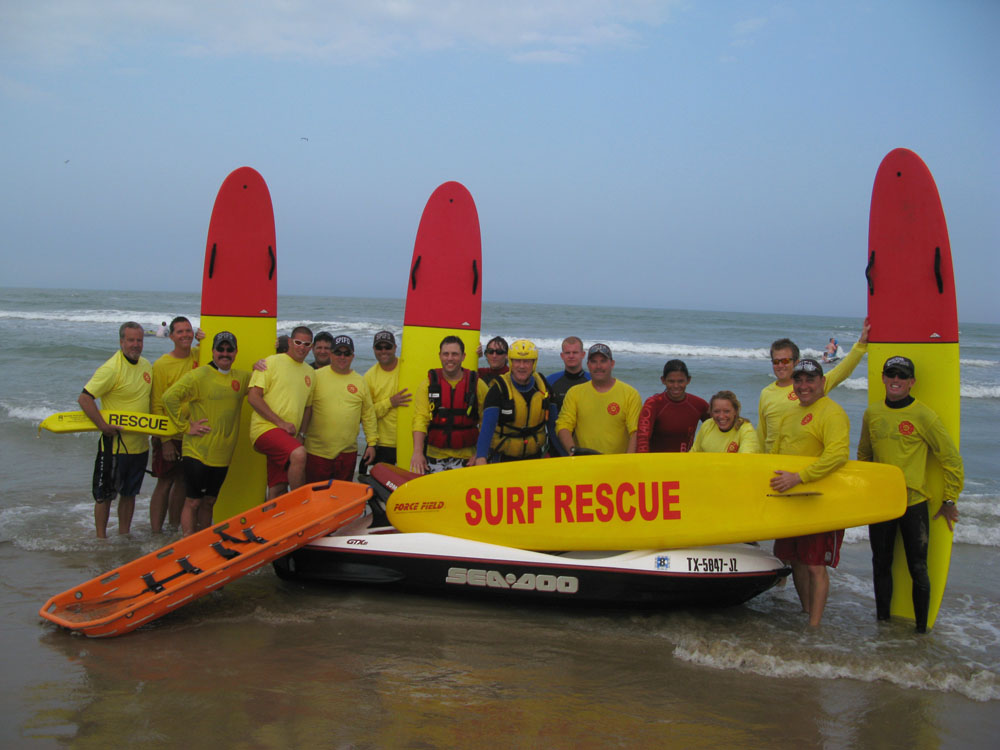
South Padre Island Fire Dept. Beach Patrol
|
Before you jump into the waves, take a few minutes to read
this important water
safety information and discuss it with your family and friends,
it may save your life!!
| Beachgoers
need to be aware of the surf conditions and related
currents. The
waves you've come here to enjoy are irresistibly beautiful
and enjoyable, yet powerful and dangerous and must
be respected, even on the days when the surf is relatively
calm. Taking simple precautions like wearing a lifejacket can easily avert a tragedy. |
BE A RESPONSIBLE PARENT, PUT LIFEJACKETS ON YOUR KIDS
OCEAN
SAFETY RULES |
1. WEAR A LIFEJACKET IF
YOU DON’T SWIM WELL. You buckle up in your car,
so should your children buckle up their lifejacket
when they swim in the surf. A lifejacket will SAVE
YOUR LIFE, it is nearly impossible to drown if you
are wearing a Coast Guard Approved Life Jacket. I have had the unpleasant task of pulling
many lifeless bodies from the surf, all of them would
be alive today if they had been wearing lifejackets.
2. LEARN TO SWIM
3 . BE AWARE OF RIP CURRENTS
4 . OBEY WARNING SIGNS AND FLAGS
5 . HAVE AN ADULT CHECK CONDITIONS FIRST
6 . DON'T SWIM ALONE
7 . STAY IN SHALLOW WATER DURING HIGH SURF
8 . NEVER LEAVE CHILDREN UNATTENDED
9 . DO NOT SWIM NEAR THE JETTY
10 . DON'T USE INFLATABLES IN THE SURF, USE A BODYBOARD WITH A LEASH OR OTHER FLOTATION DEVICE
11. DON'T OVERESTIMATE YOUR SWIMMING ABILITY
12. DON'T DRINK AND SWIM |
Rip
Currents |
Rip currents
(mistakenly called rip tides or undertows) are common
and can be found almost daily on all South Padre
Island Beaches. RIP CURRENTS KILL SWIMMERS EVERY
YEAR HERE AT SOUTH PADRE ISLAND. Rip currents occur
around the world at "surf" beaches, including
both the Atlantic and Pacific coasts, the Great
Lakes, and the Gulf of Mexico including South Padre
Island. Rip currents are also the #1
cause of drownings. If you are caught
in one, how you respond could make the difference
between life and death. Unlike undertows, rip currents
are shallow water processes that do not pull a person
under. They form when water, piled against the shore,
begins to return to deeper water. Typically, strong
wind and swell waves push water over a sandbar allowing
excess water to collect. Eventually, the excess
water starts to return seaward through low areas
in the sandbar, "ripping" an opening.
Rip currents can be readily seen from the shore.
You can spot a rip current by looking for objects
or foam moving steadily seaward. Wave heights are
also lower and choppier in rip currents. Since rip
currents are NOT undertows, you can be pulled
away from the shore but not pulled under the water. The most common mistake drowning victims make
is to panic and try to swim directly toward the
shore. Even the best Olympic swimmers are not able
to successfully swim toward shore in the strongest
rip currents. If caught in a rip current,
simply remain calm and swim or paddle to the side
and the surf will push you back towards shore. Do
not hesitate to call for assistance.
Rip
Currents are common, be aware!
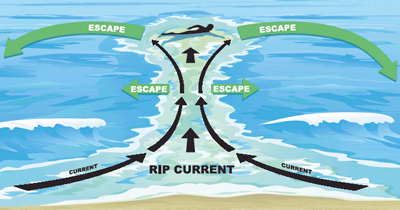 |
Rip Current Index
Rip Current Outlooks generally use the following, three-tiered
set of qualifiers:
Low
Risk - Wave Heights 0-2' and/or
Wind Speed less than 10 kts.
Wind and/or wave conditions are not expected
to support the development of rip currents; however, rip currents can sometimes
occur, especially in the vicinity
of groins, jetties, and piers.
Moderate Risk - Wave
Heights 3-5' and/or Wind Speed 10-20 kts.
Wind and/or wave conditions support stronger
or more frequent rip currents. Only experienced
surf swimmers should enter the water. Use a
lifejacket, bodyboard or flotation device.
High Risk - Wave Heights 6'+ and/or
Wind Speed greater than 20kts.
Wind and/or wave conditions support dangerous
rip currents. Rip currents are life-threatening
to anyone entering the surf. Stay in waist deep
water or less!
-Rip
currents are NOT undertows,
you can be pulled away from
the shore but not pulled
under the water. |
-If
caught in a rip current, simply
remain calm and swim or paddle to the
side and the surf will push
you back towards shore. |
|
|
FLAG
ADVISORY SYSTEM |
Surf
Conditions |
FLAG
ADVISORY SYSTEM |
sistema
de aviso con bandera |
| .... |
-heavy
surf
-dangerous currents |
-oleaje
fuerte
-corrientes Peligrosas |
| .... |
-calm
to moderate water
-does not mean safe water |
-agua
calmada a moderada
-no asuma agua segura |
| .... |
-presence
of
venemous marine life |
-presencia
de
vida marina venenosa |
Absence
of flag does not assure safe water
La ausencia de banderas no asume
condiciones de agua segura |
Dial
911 for emergency
Marque el 911 para urgencias |
|
As
you enter beaches you will notice the Flag Advisory
signs.
|
Riptides |
| Riptides
are found in channels, passes and cuts through which
large volumes of water travel from the bay to the
surf during the tidal exchange. Normally swimmers
are not found in these areas. Rip currents are commonly
and mistakenly called riptides. |
Holes,
Sandbars and Dropoffs |
| The
waves may SEEM calm at times and
the ocean look safe, but the bottom is irregular and
uneven with quick dropoffs and deep holes. These conditions
change daily. When you step off the beach, in just
a few steps you can be in 5-7' of water, this is very
dangerous for children and non-swimmers. After this
first trough, the first sandbar is around 50 feet
out and can be a shallow as 1-2' on a low tide or
much deeper on a high tide. There are many deep holes,
even in shallow water. You may be wading in 2' of
water and take one step and be in 6' of water. This
is very common in the first trough close to shore.
Wear a lifejacket and you won't disappear in a deep
hole. |
Longshore
Currents |
| Longshore
Currents are simply the current that moves
along the beach, usually in the direction that the
wind is blowing or the waves are breaking. You will
notice the longshore current as you enter the water,
causing you to drift along the beach. These currents
can run as fast as 3mph. Not a hazard for swimmers,
unless there is a north wind, the longshore current
will sweep you towards the jetty where it will become
a rip current sucking out to sea. |
Tides |
The
tide plays an important factor in water depths in
the surf. The tide range, or difference between high
and low tide varies between 1 to 3 feet. High tide
will cause more powerful waves to break closer to
shore and deeper water near shore. A
low or outgoing tide can greatly increase the rip
current risk.
|
The
Jetties |
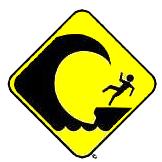
If
the rocks are wet from waves,
DO NOT walk any further!
|
Jetties - Located at the southern
tip of the island in Isla Blanca Park, the jetties
are not designed for public access, although it is
allowed. Never swim
near the jetty. Many people have been
swept off the rocks and injured or swept out to sea
in the strong rip next to the jetty while attempting
to walk out the jetty during high surf. The granite
boulders are barnacle encrusted and urchin infested. Always bring some type
of flotation device to be used for rescue in case
someone falls into the surf. There is a strong rip
current located next to the jetty. This rip current
is the strongest and most dangerous on the entire
Texas coast, and on big days it can suck you out to
the end of the jetty into the "pit" where
the biggest waves will break, and likely wash you
back onto the rocks. If you get caught in the rip, simply remain calm and swim or
paddle to the side away from the jetty and the
surf will push you back towards shore. Do not hesitate
to call for assistance.
|
|
| |
Surf
Rescue |
If
you notice a swimmer in distress in the
surf, first have someone call 911. Then,
before you ever attempt a rescue, be sure
to take some type of floating
object such as a bodyboard
or inflatable float or you are very likely
to also be a drowning victim.
As you approach the victim, present the
float to the victim, keeping the float BETWEEN
you and the victim, and continually reassure
the victim and make your way towards shore.
If you happen to be caught in a rip current
with the victim, remember to paddle across
the current, then back towards the beach.
Surfers click here
for info on rescue by a surfer |
Undertow |
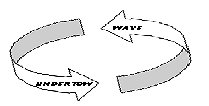
|
Undertow
is a concern mostly for weak swimmers or the
unfortunate non-swimmer. An undertow occurs
when a wave is about to break on a shallow
sandbar where a swimmer might be standing.
The water will suck underneath the wave as
it breaks. This "undertow" can sweep
a weak swimmer off of their feet and into
deeper water, and he may panic as the wave
crashes over his head. The undertow disperses almost immediately
until the next wave approaches, then the cycle
starts again. An undertow can drown a person
just feet from safety. |
Stingray |
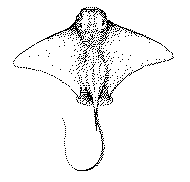 |
Stingray
are occasionally found in shallow surf
and have a sharp barb at the base of their
tail that leaves a small puncture wound,
and injects a very painful venom. The
pain will travel up the legs to the groin
and armpits. APPLY HEAT IMMEDIATELY (never
ice) directly to the wound. It is advisable
to seek follow-up medical attention.
Infection rate is 100% |
|
Jellyfish |
|
Whenever
a blue advisory flag is flying, stinging
jellyfish are likely in the surf. Reactions
vary in individuals. Rinse with fresh
water, in most cases the sting may be
treated with vinegar and unseasoned
meat tenderizer mixed in a paste, applied
directly to the sting. |
|
|
NO GLASS BOTTLES ARE ALLOWED ON THE BEACH.
DON'T LITTER.
PICK UP SOME TRASH THAT ISN'T YOURS.
Local
Emergency Numbers |
CALL
911 first for any emergency.
South Padre Island EMS (956) 761-5454
Cameron County Park System (956) 761-5494
U.S. Coast Guard Station South Padre Island (956)
761-2668
Cameron County Parks Police (956) 761-5283
|
(This
Water Safety Information was written by local Ocean Safety
expert Gene Gore with the purpose of educating visitors
to
South Padre Island in the hope of preventing drownings.
For additional questions or comments feel free to email
Gene. )

Surfing Lessons and Surf Camps at South Padre Island!
|



